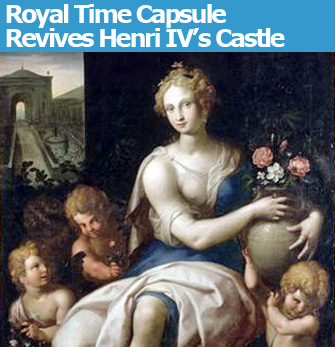 |
|
Detail of “Flora” by Ambroise Dubois, on show at the Château de Fontainebleau. |
 |
|
Detail of “Flora” by Ambroise Dubois, on show at the Château de Fontainebleau. |
The well-preserved Château de Fontainebleau is a palimpsest illustrating the tastes of French kings and emperors from François I to Napoleon III. Each one left his mark on the architecture and/or decor of the sprawling château, often at the expense of the work of his predecessors.
Henri IV (1553-1610), the first Bourbon king of France, spent a great deal of time at Fontainebleau – returning every year after he became king – and a great deal of money redecorating it. The château’s current exhibition, “Henri IV à Fontainebleau: Un Temps de Splendeur,” celebrates the four-hundredth anniversary of his death with a kind of time capsule that reunites now-scattered vestiges of the château as Henri and his family and mistresses saw it, and directs the attention of visitors to those parts of it that remain intact.
Henri led an eventful life. Born Henri de Bourbon, he was a practicing Calvinist who fought in the Wars of Religion on the side of the Huguenots and became King Henry III of Navarre in 1572. He renounced his faith and became a Catholic after his marriage to Marguerite de Vallois (a.k.a. La Reine Margot) in 1572 at Notre Dame (not being a Catholic at the time, Henri had to stand outside the cathedral during the ceremony), which was followed by the assassination of thousands of Protestants who had come to Paris to celebrate his wedding during the St. Bartholomew’s Day Massacre. He later renounced his renunciation and became a Protestant again.
He once again became a Catholic after being crowned king of France in 1589. A year after his childless marriage to Marguerite was annulled in 1599, he married Marie de’ Medici, who bore him six children. Henri promulgated the Edict of Nantes in 1598, which gave Protestants some freedom to practice their religion (it was revoked in 1685 by Louis XIV), but religious disputes ruled the existence of this popular king right to the very end: he was assassinated in 1610 by a fanatical Catholic, François Ravaillac.
Notable accomplishments of his reign that can be seen in Paris include the Pont Neuf, the Place des Vosges (originally the Place Royale) and the Louvre’s Grande Galerie.
To take full advantage of this exhibition, first visit the show itself, which offers documentation on now-missing elements of the château in Henri’s time in the form of architectural plans, engravings, re-creations, objects and remnants of artworks, as well as a number of paintings – notably those by Flemish painter Ambroise Dubois (né Ambrosius Bosschaert) – that have been removed from their original settings. The last section, on family life in the château, is especially interesting (an anonymous painting, for example, shows the royal family picnicking at a table in the middle of the forest, waited on by a stream of servants). Unfortunately, good knowledge of French is required to understand the exhibition’s explanatory texts, since none of them have been translated.
Once you have absorbed the information on offer, wander through the château looking for the large white panels that point out where the changes made in Henri XIV’s time have been preserved. You will see the château with new eyes and a better understanding of the layers of transformation it has undergone over the centuries.
One example is the Belle Cheminée, an extravagant monumental marble fireplace made by Mathieu Jacquet for Henri, which has been dismantled and is partially re-created in the exhibition; the equestrian statue of Henri that was its centerpiece is still part of the fireplace in the second Salle Saint Louis.
Don’t miss a visit to the ground-floor Galerie des Cerfs, which is not usually open to the public. Lit by 22 large windows looking out onto the Jardin de Diane (once the queen’s private garden), it is completely decorated with paintings of French royal estates, among them Chambord, Ambroise,
| {youtube}L7bxanZN3so{/youtube} |
|
The Galerie des Cerfs, the Galerie de Diane and the grounds of the Château de Fontainebleau. |
Blois and the Louvre, interspersed with stags’ head. Also on display are a number of bronze statues by Primatrice, the artist responsible for much of the decoration of the château under its builder, François I.
Flash forward a couple of centuries in the château’s history: While I was in the gallery, a passing tour guide mentioned that when Napoleon inhabited Fontainebleau, he gave his beloved but rather overbearing mother the bedroom on the other side of the wall at the end of this long gallery, the most out-of-the-way bedroom in the château.
End your visit with a look at the Chapelle de la Trinité, which still retains many of the decorations ordered by Henri, notably the ceiling paintings by Martin Fréminet. Outdoors, notice the elaborate Porte Dauphine, which was built to commemorate the baptism of Henri’s heir, the future Louis XIII, which took place in the courtyard.
When you leave the château, I highly recommend that you return to the train station by walking along the 1,200-meter canal built by Henri in the château’s lovely park.
Château de Fontainebleau: 77300 Fontainebleau. Tel.: 01 60 71 50 70. Open 9am-5pm. Closed Tuesday. 15-minute bus ride (line A) from Fontainebleau-Avon train station. By car: Autoroute A6, Fontainebleau exit. www.musee-chateau-fontainebleau.fr
Order books on the Château de Fontainebleau from Paris Update’s Amazon store at no extra cost. Click on your preferred Amazon location: U.K., France, U.S.
Support Paris Update by ordering books from Paris Update’s Amazon store at no extra cost. Click on your preferred Amazon location: U.K., France, U.S.
Reader Reaction: Click here to respond to this article (your response may be published on this page and is subject to editing).
More reviews of Paris art shows.
© 2011 Paris Update
